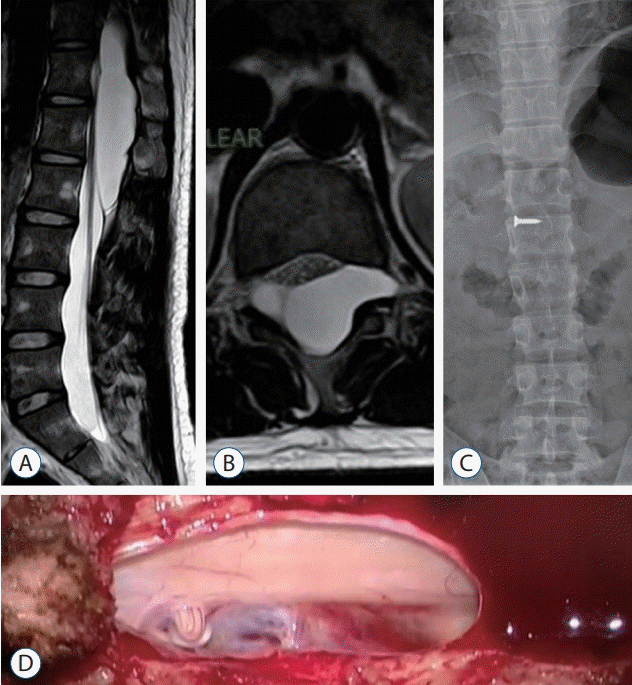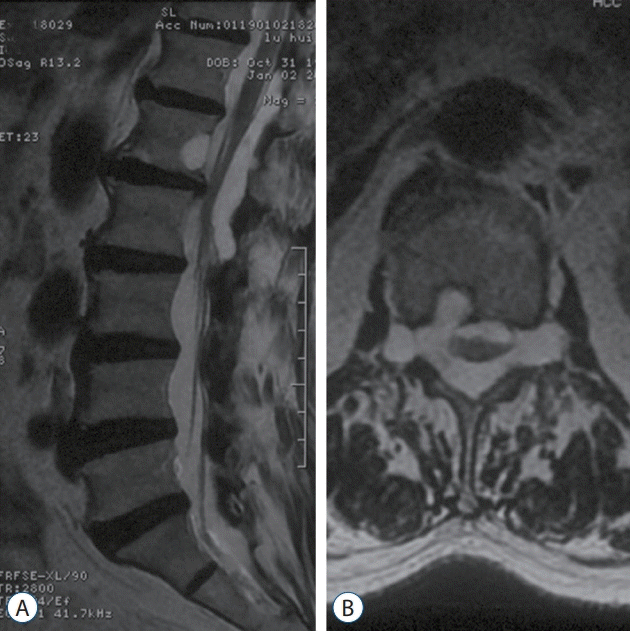1. Chen Z, Sun XL, Zhao Y, Wang K, Jian FZ. Dural dissection cyst: a more accurate term for extradural meningeal cyst. CNS Neurosci Ther. 20:515–520. 2014.

2. Choi JY, Kim SH, Lee WS, Sung KH. Spinal extradural arachnoid cyst. Acta Neurochir (Wien). 148:579–585. 2006.

3. Funao H, Nakamura M, Hosogane N, Watanabe K, Tsuji T, Ishii K, et al. Surgical treatment of spinal extradural arachnoid cysts in the thoracolumbar spine. Neurosurgery. 71:278–284. 2012.

4. Furtado SV, Thakar S, Murthy GK, Dadlani R, Hegde AS. Management of complex giant spinal arachnoid cysts presenting with myelopathy. J Neurosurg Spine. 15:107–112. 2011.

5. Garg K, Borkar SA, Kale SS, Sharma BS. Spinal arachnoid cysts - our experience and review of literature. Br J Neurosurg. 31:172–178. 2017.

6. Gu K, Kwon JW, Kim ES. Digital subtraction cystography for detection of communicating holes of spinal extradural arachnoid cysts. Korean J Radiol. 17:111–116. 2016.

7. Hatashita S, Kondo A, Shimizu T, Kurosu A, Ueno H. Spinal extradural arachnoid cyst--case report. Neurol Med Chir (Tokyo). 41:318–321. 2001.
8. Ishibe T, Senzoku F, Ikeda N, Kamba Y, Mikawa Y. Detection of the communicating hole(s) of spinal extradural arachnoid cysts using timespatial labeling inversion pulse magnetic resonance imaging. Spine (Phila Pa 1976). 39:E1394–E1397. 2014.

9. Ishibe T, Senzoku F, Kamba Y, Ikeda N, Mikawa Y. Time-spatial labeling inversion pulse magnetic resonance imaging of cystic lesions of the spinal cord. World Neurosurg. 88:693.e13–693.e21. 2016.

10. Kikuta K, Hojo M, Gomi M, Hashimoto N, Nozaki K. Expansive duraplasty for the treatment of spinal extradural arachnoid cysts: case report. J Neurosurg Spine. 4:251–255. 2006.

11. Klekamp J. A new classification for pathologies of spinal meninges, part 1: dural cysts, dissections, and ectasias. Neurosurgery. 81:29–44. 2017.

12. Lee CH, Hyun SJ, Kim KJ, Jahng TA, Kim HJ. What is a reasonable surgical procedure for spinal extradural arachnoid cysts: is cyst removal mandatory? Eight consecutive cases and a review of the literature. Acta Neurochir (Wien). 154:1219–1227. 2012.

13. Lim MS, Khalil A, Okafo U, Dunlea O, Kaar G. Hemilaminectomy for large spinal extradural meningeal cysts: a case report and review of surgical techniques. Ann R Coll Surg Engl. 98:e162–e164. 2016.

14. Liu JK, Cole CD, Kan P, Schmidt MH. Spinal extradural arachnoid cysts: clinical, radiological, and surgical features. Neurosurg Focus. 22:E6. 2007.

15. Millward CP, Bhagawati D, Chan HW, Bestwick J, Brecknell JE. Retrospective observational comparative study of hemilaminectomy versus laminectomy for intraspinal tumour resection; shorter stays, lower analgesic usage and less kyphotic deformity. Br J Neurosurg. 29:390–395. 2015.

16. Mishra RK, Pruthi N, Bharath RD, Malla BR. Role of intraoperative dynamic magnetic resonance myelogram in management of giant dorsolumbar spinal extradural arachnoid cyst: case report. J Neurosurg Spine. 27:185–188. 2017.

17. Miyakoshi N, Hongo M, Kasukawa Y, Shimada Y. Huge thoracolumbar extradural arachnoid cyst excised by recapping T-saw laminoplasty. Spine J. 10:e14–e18. 2010.

18. Miyamoto M, Kim K, Matsumoto R, Isobe M, Isu T. Utility of preoperative magnetic resonance imaging myelography for identifying dural defects in patients with spinal extradural arachnoid cysts: case report. Neurosurgery. 59:E941. 2006.

19. Morizane K, Fujibayashi S, Otsuki B, Sakamoto T, Tsutsumi R, Odate S, et al. Clinical and radiological features of spinal extradural arachnoid cysts: valve-like mechanism involving the nerve root fiber as a possible cause of cyst expansion. J Orthop Sci. 23:464–469. 2018.

20. Nabors MW, Pait TG, Byrd EB, Karim NO, Davis DO, Kobrine AI, et al. Updated assessment and current classification of spinal meningeal cysts. J Neurosurg. 68:366–377. 1988.

21. Neo M, Koyama T, Sakamoto T, Fujibayashi S, Nakamura T. Detection of a dural defect by cinematic magnetic resonance imaging and its selective closure as a treatment for a spinal extradural arachnoid cyst. Spine (Phila Pa 1976). 29:E426–E430. 2004.

22. Netra R, Min L, Shao Hui M, Wang JC, Bin Y, Ming Z. Spinal extradural meningeal cysts: an MRI evaluation of a case series and literature review. J Spinal Disord Tech. 24:132–136. 2011.
23. Oh JK, Lee DY, Kim TY, Yi S, Ha Y, Kim KN, et al. Thoracolumbar extradural arachnoid cysts: a study of 14 consecutive cases. Acta Neurochir. 154:341–348. 2012.

24. Qi W, Zhao L, Fang J, Chang X, Xu Y. Clinical characteristics and treatment strategies for idiopathic spinal extradural arachnoid cysts: a single-center experience. Acta Neurochir (Wien). 157:539–545. 2015.

25. Tokmak M, Ozek E, Iplikcioglu AC. Spinal extradural arachnoid cysts: a series of 10 cases. J Neurol Surg A Cent Eur Neurosurg. 76:348–352. 2015.

26. Tureyen K, Senol N, Sahin B, Karahan N. Spinal extradural arachnoid cyst. Spine J. 9:e10–e15. 2009.

27. Woo JB, Son DW, Kang KT, Lee JS, Song GS, Sung SK, et al. Spinal extradural arachnoid cyst. Korean J Neurotrauma. 12:185–190. 2016.









 PDF
PDF Citation
Citation Print
Print



 XML Download
XML Download